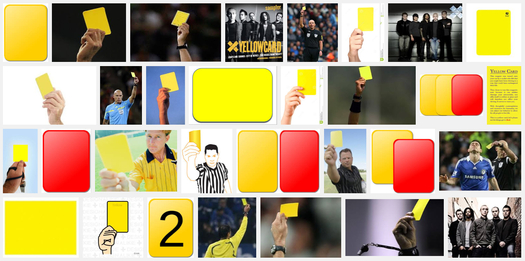
Every four years, I succumb to the World Cup. And while I appreciate the explosive moments — thrilling goals, nerve-rattling near-misses, epic triumphs and failures — I also appreciate the meandering passages when the mind wanders to the atmospherics and aesthetics of this spectacle.
To be specific: Every four years, at some point, I get interested in the yellow card.
As objects go, it doesn’t look like much. It’s, you know, a yellow card. But when theatrically brandished by an official, almost literally in the face of a player who has done something uncool, it has wild power. It sets off a stadium-full of whistling, and cartoonish arm-flailing from the carded player and his colleagues. A yellow card has real consequences: Possession, a free kick, and the possibility that if the carded competitor blunders again he’ll leave his team understaffed for this match, and will sit out the next.
It strikes me as more interesting than the other penalty card, the red. That one results in instant ejection, in response to some plainly egregious act. Its presentation is memorable, of course. But the yellow card is both more ambiguous and more humane. It’s a warning: There’s trouble; but it could be worse.
A mild round of curiosity-driven Web research tells me a little about the yellow card, but not as much as I’d like. According an item on FIFA’s site, the penalty-card notion was invented by an official named Ken Aston, in the wake of a 1966 World Cup quarterfinal match between England and Argentina. Apparently there was some controversy about whether the referee had clearly communicated penalty warnings leveled against two English players:
It started a train of thought in Aston's head too. He began to think about ways to avoid such problems in the future. "As I drove down Kensington High Street, the traffic light turned red. I thought, 'Yellow, take it easy; red, stop, you're off'."
Yellow and red penalty cards became part of the World Cup in 1970, and are of course now a routine element of soccer and (according to Wikipedia, anyway) a number of other sports.
The cards are a such a brilliant solution to the problem of making sure a penalty has been adequately signaled — they transcend language; they’re clear not just to everyone on the field, but in the stadium, or watching on a screen — that it’s hard to imagine the game without them.
Moreover (and this is the line of thought that idle World Cup moments lead me to every four years), I semi-seriously wish we could port the card system into daily life. Imagine a yellow card as a warning to the shop employee whose insolence is getting close to inspiring a boycott; to the dinner companion whose habit of checking his phone is on the verge of becoming a friendship-ender; to the aggressive tailgater who is just about to inspire a road-rage incident.
What my light Internet research failed to turn up is any solid information about the physical card itself. Surely there must be FIFA standards dictating the dimensions of the thing, the material from which it’s made. Presumably there is an official supplier, a set of guidelines about how many cards the officials carry, and under what circumstances a bent or sullied card ought to be replaced with a fresh one.
I couldn’t find anything about that. Maybe this is an example of mystique feeding power: The physical details of the object may be obscure, but its symbolic impact is instant and universally understood (at least among soccer fans). And it’s not hard to imagine that it would be quite compelling to scrutinize the actual yellow cards issued in crucial matches across the decades: Like the thousands of baseballs in Cooperstown, they are presumably not so materially different, but each taps into a specific story, and thus has a unique meaning.
Perhaps there is a collection of penalty cards in some museum? I frankly hope so, but haven’t turned up any suggestion of such a thing. If you know better — about that, or any other aspect of the penalty card as object — please let me know in the comments or via email (consumed AT robwalker DOT net).
